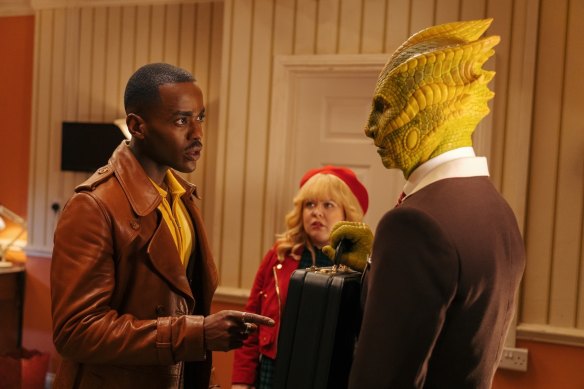
The history of the show is wildly diverse: more than a dozen actors have played The Doctor, from William Hartnell and Patrick Troughton, to Jon Pertwee, Tom Baker, David Tennant, Matt Smith and, now Ncuti Gatwa. That said, whether it is Peter Davison or Jodie Whittaker, the essential qualities of the character remain (mostly) the same as they were in 1963.

The Doctor (Ncuti Gatwa), Joy (Nicola Coughlan) and Hotel Manager (Jonathan Aris).Credit: Disney+
“Part of the joy of it is that since 1963, it’s been 61 years, and we’re still finding new things for the character to do,” says the show’s producer, Russell T. Davies. “That’s actually one of literature and cinema and television’s all-time great characters. That’s amazing. That’s a vision. And they can be, in a way, these figures can be redone again and again and again with new aspects and new insights and new imagination applied to it.
“It’s a literary quality, actually, which means he’s constant, or they are constant, and that’s a joy,” adds Davies. “It also makes you work very hard as a writer, that you can never quite take it easy. And if you are taking it easy, something is wrong. You just trot it out, an ordinary old doctor, saying, well, what’s that? There’s no such thing. That’s a sign in a fictional character that he’s much cleverer than we are. And so, you’ve got to absolutely be fighting fit to be writing it.”
The sense of melancholy that pervades the dark detail of the stories also taps into the character of the Doctor himself: a lone wandering Time Lord, the last survivor of a terrible Time War which claimed his own people, and also their deadliest enemies, the Daleks. The series, particularly in its post-2005 reboot, has leaned into the darker and more sorrowful side of the character.
“There is [this side] to everybody, isn’t there?” Davies says. “Happiness is the antidote to something. It’s the antidote to everything else. Every day you spend happy is a victory because we all know how this ends, and it ain’t good. I’m not sure that anyone isn’t like that.
“The Doctor is like that too, but he knows what to do about it,” adds Davies. “Run, see things, make friends, have a laugh, never resent anything, be joyful in the face of everything. However dangerous and terrifying and awful it is, he gets a kick out of it. As [former Doctor] Tom Baker said, he is in celebration of everything, including danger. And that’s a marvellous way to be.”
One curious trend, in recent years, is that the show leans a little less into its ancient history. So there might be obligatory episodes focusing on the Daleks, or another historic villain, the Cybermen, but other monsters from the show’s historic canon, such as Zygons, Movellans and Ice Warriors, either fully developed or glimpsed in the new series, feel less frequent.
Loading
“I wanted the show to be wilder, and almost kind of simpler in that you can have episodes like “The Devil’s Chord” in which they make Jinkx Monsoon as Maestro,” Davies says. “But in that story, that’s just the Doctor and Ruby arriving and meeting an enemy and fighting them for 45 minutes. That’s all they do. But again, that doesn’t feel far from 1963 at all.”
Moffat concurs, noting that in many respects it is the more recent iterations of Doctor Who that are a little more structured, when compared to the earliest seasons in the 1960s and 1970s, where there was no firm playbook.
“It actually … becomes straighter as it goes and one of the reasons that I like [the 1970s-era Doctor Who serial] The Ark in Space so much, as I know Russell does, is you could take that script exactly as it is, just change a couple of names and give it to any of the regular cast of Doctor Who, and redo it. It would work fine with Hartnell and [companions] Ian and Barbara and Susan, it would work fine with Ncuti and whatever team he had with him. It’d be fine.”
Doctor Who: Joy to the World screens on Disney+ from Thursday, December 26.
Find out the next TV, streaming series and movies to add to your must-sees. Get The Watchlist delivered every Thursday.



